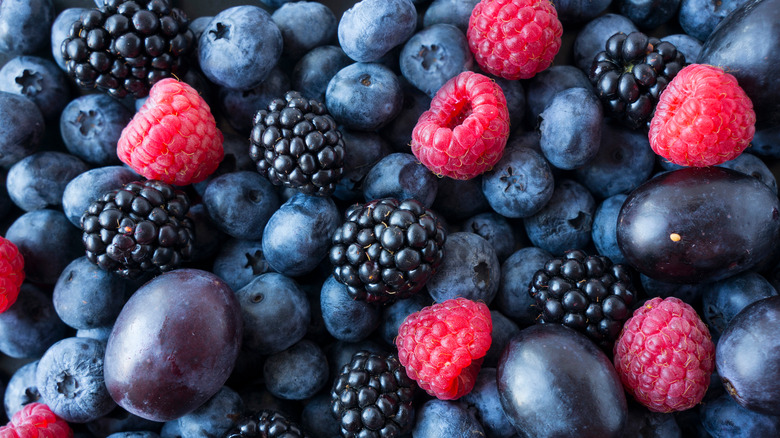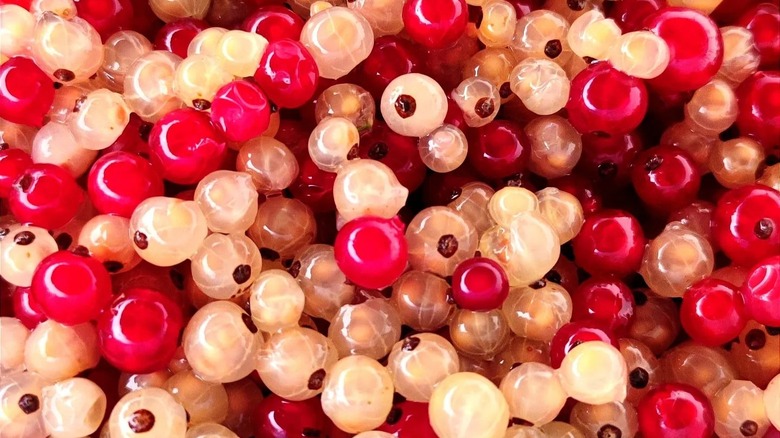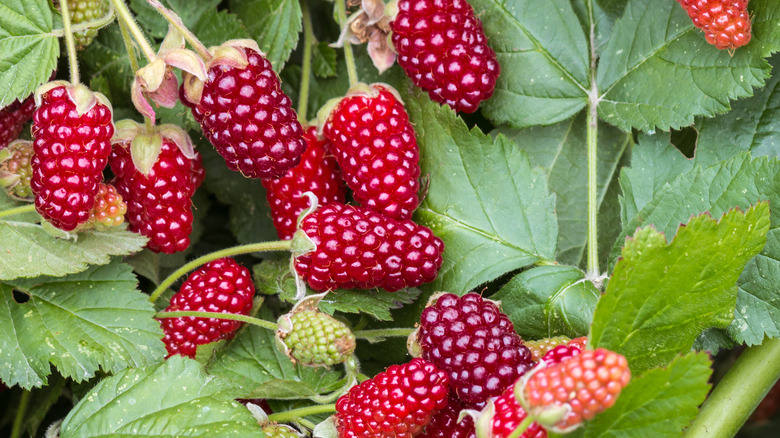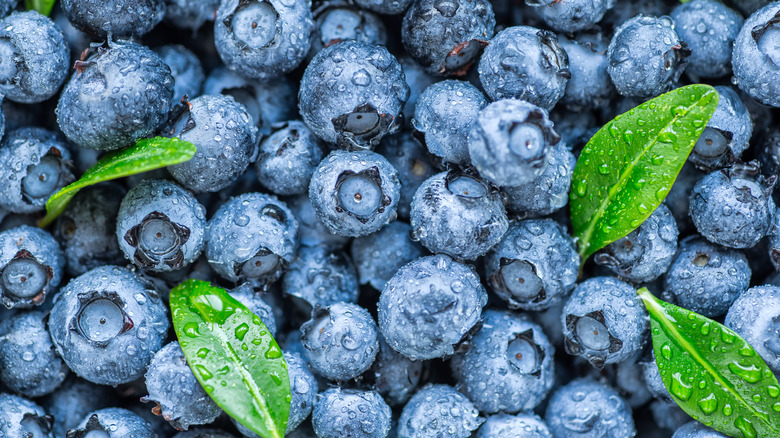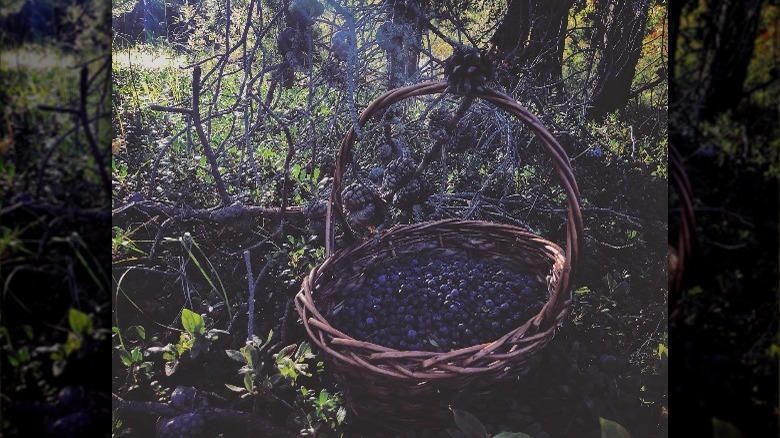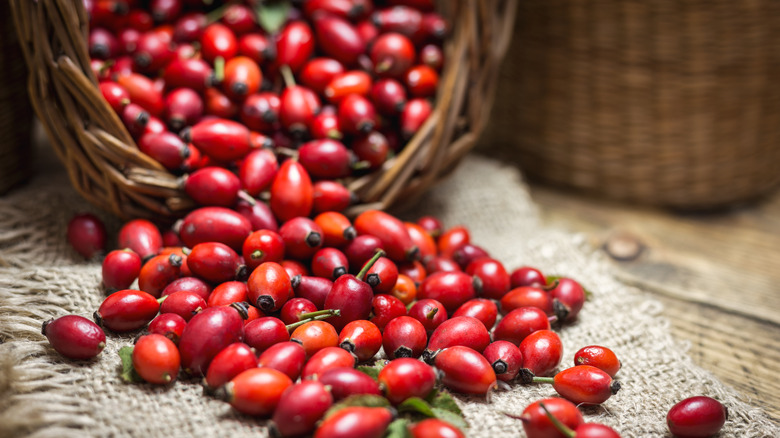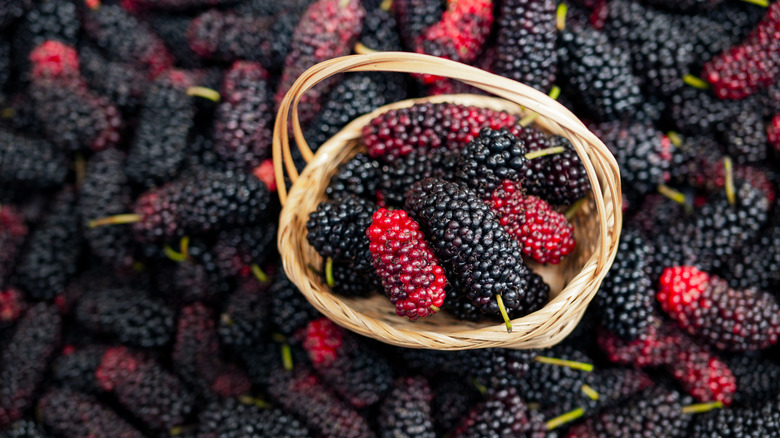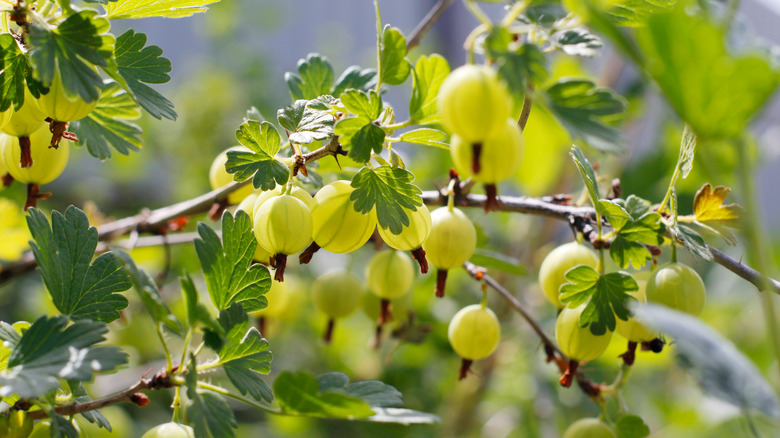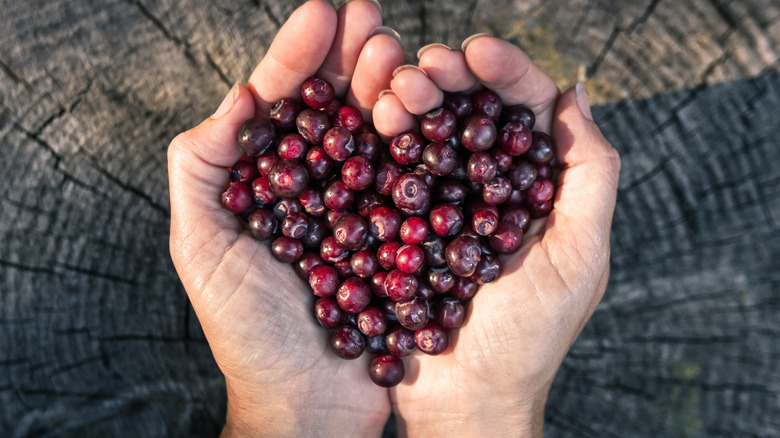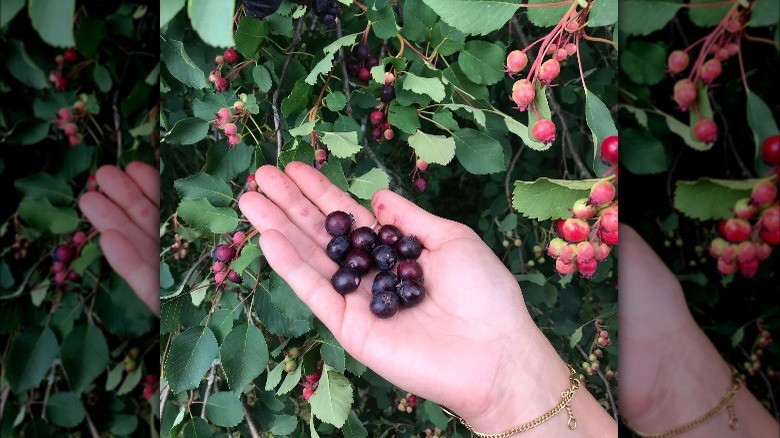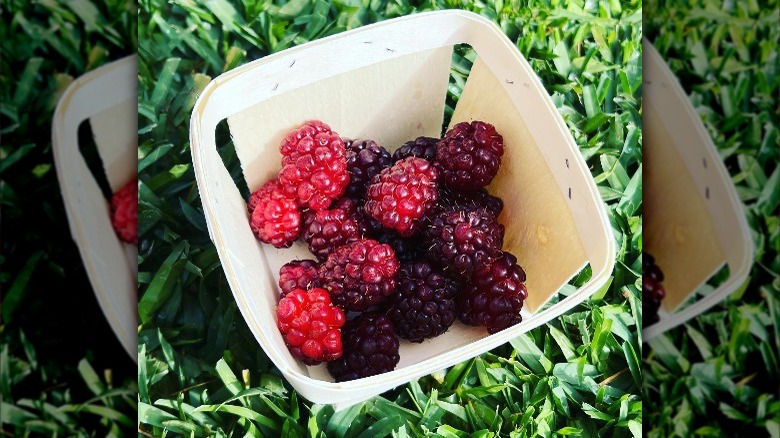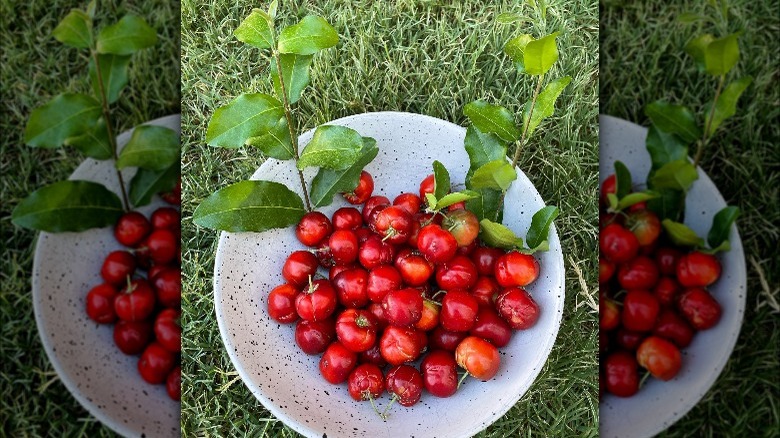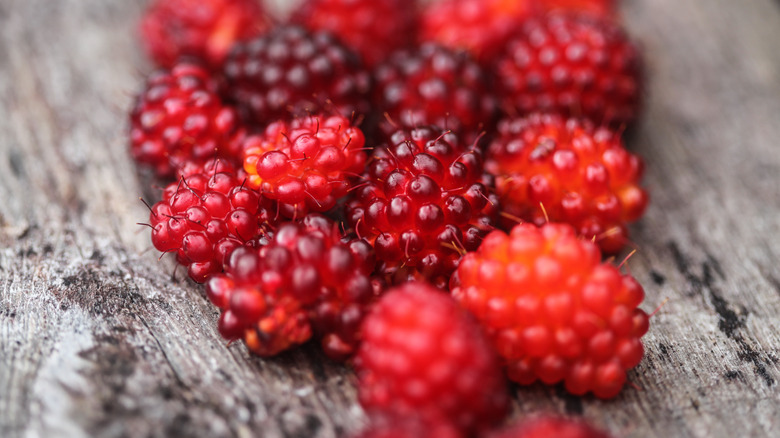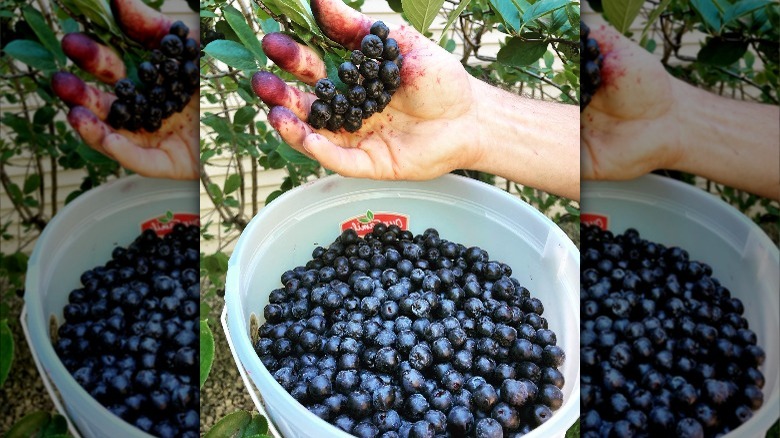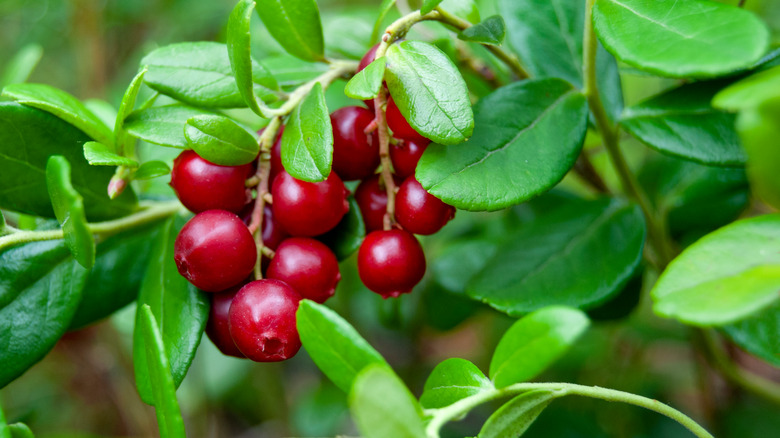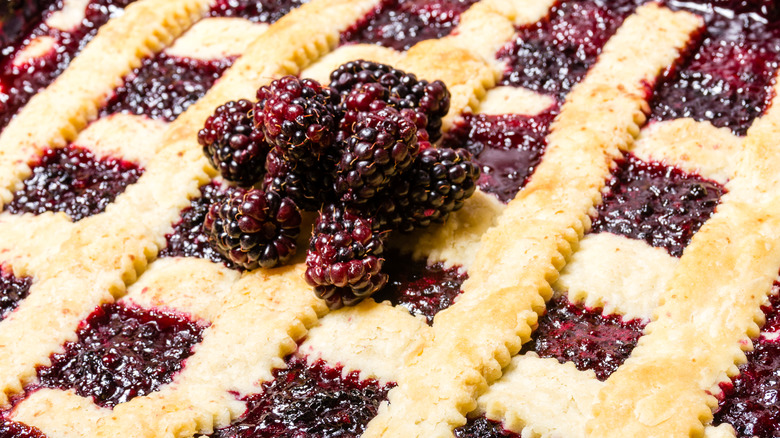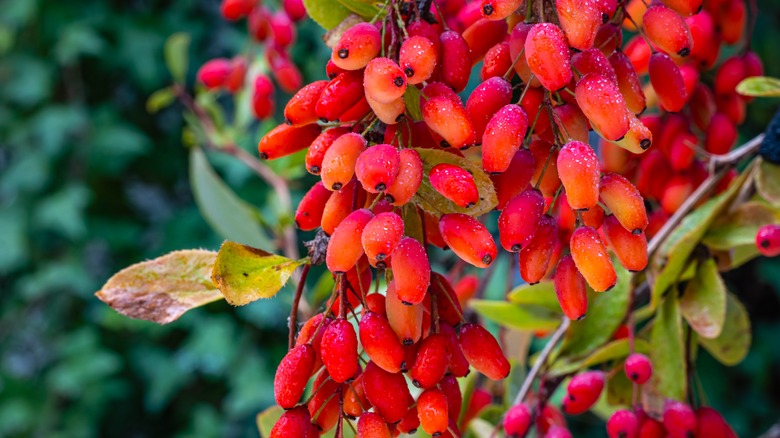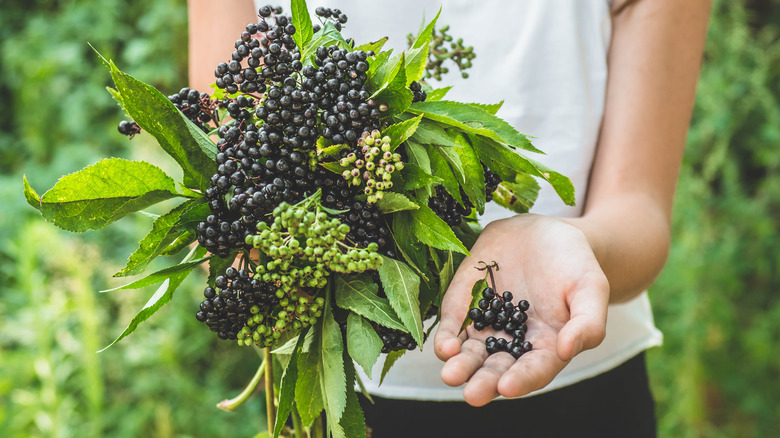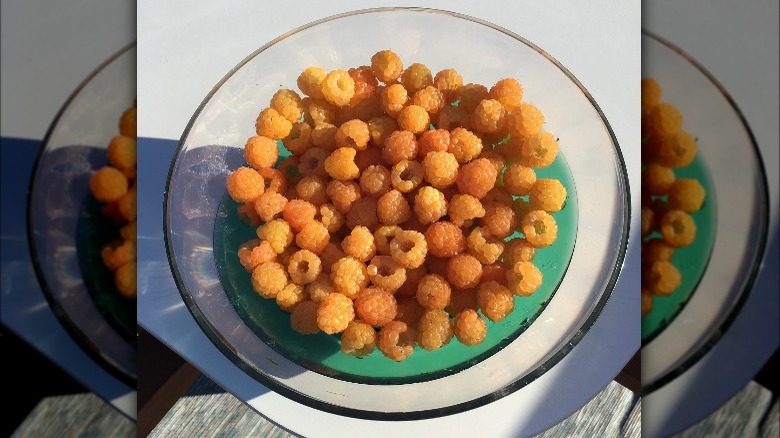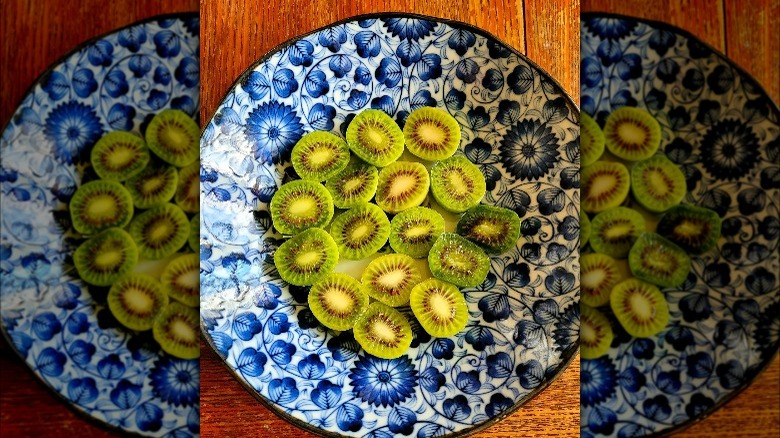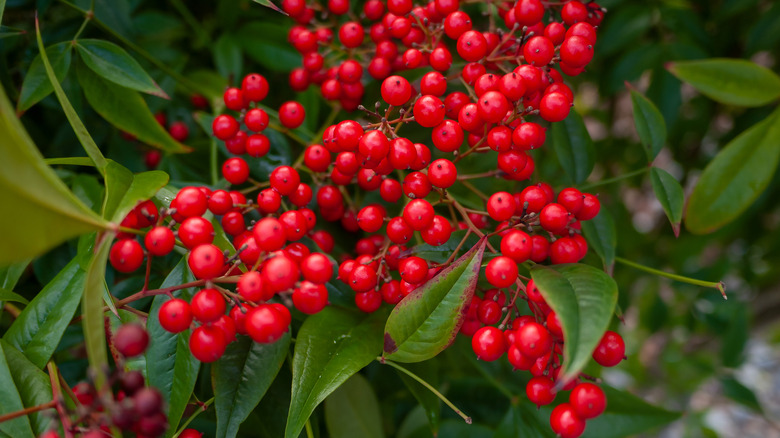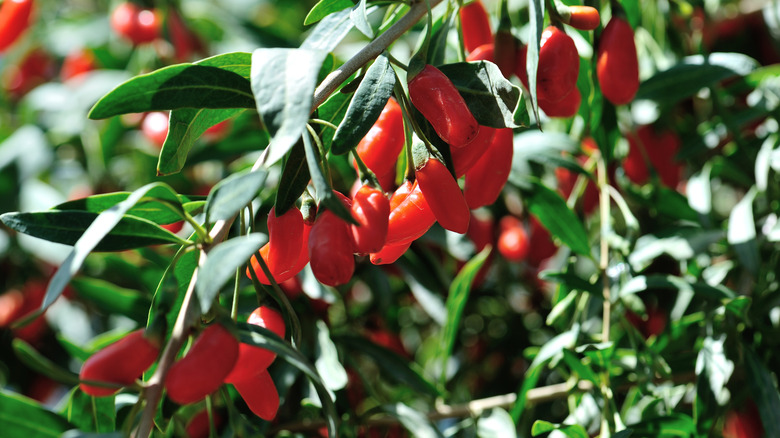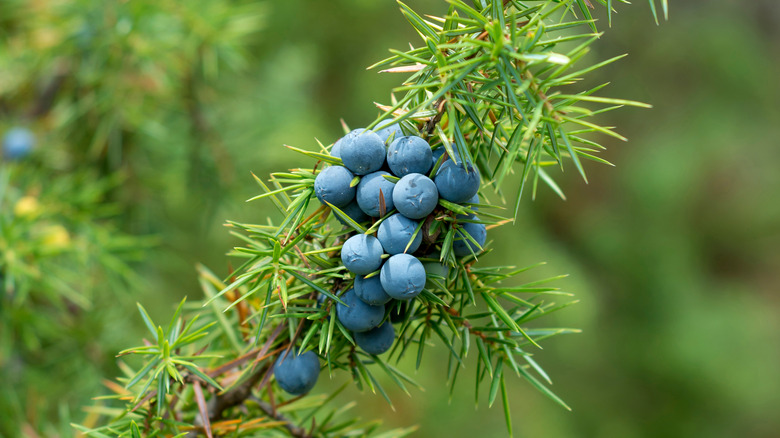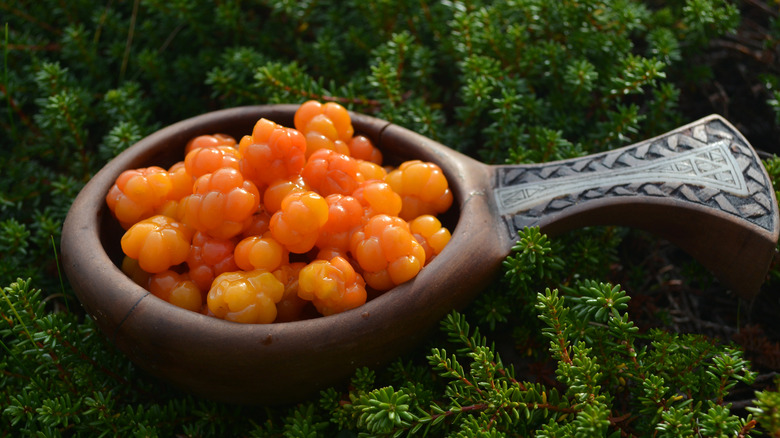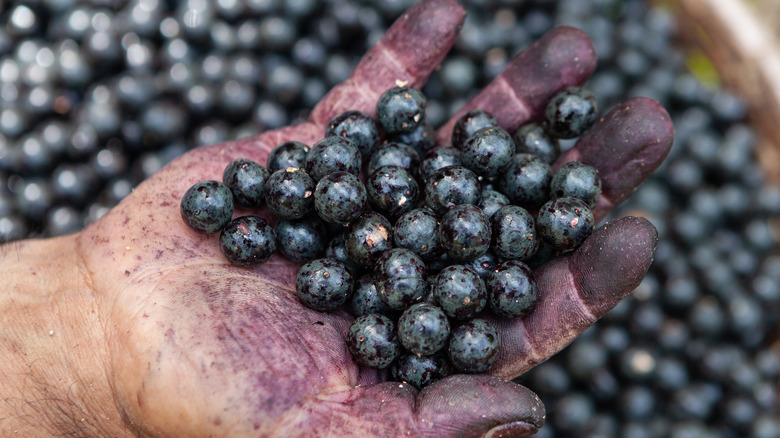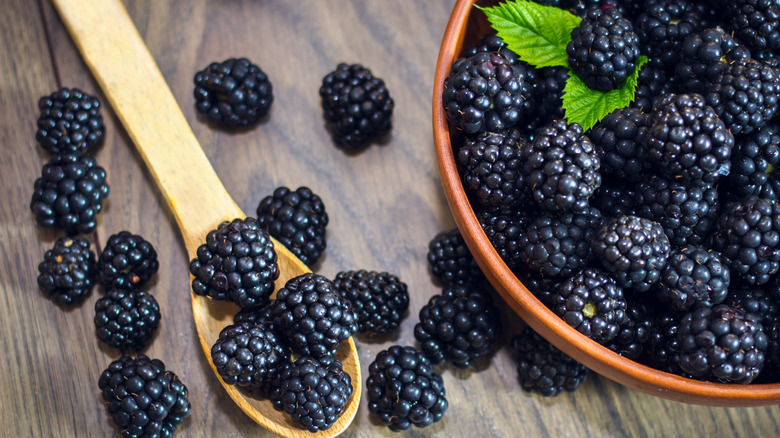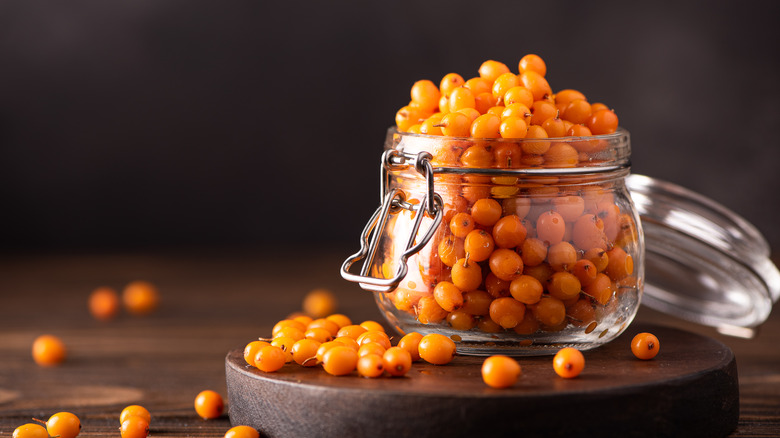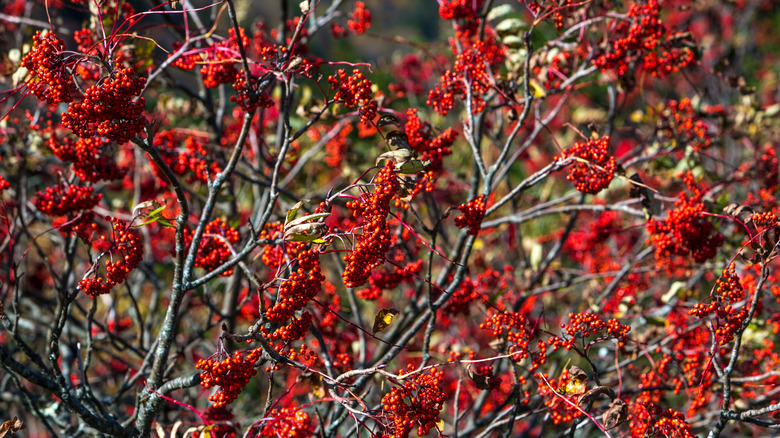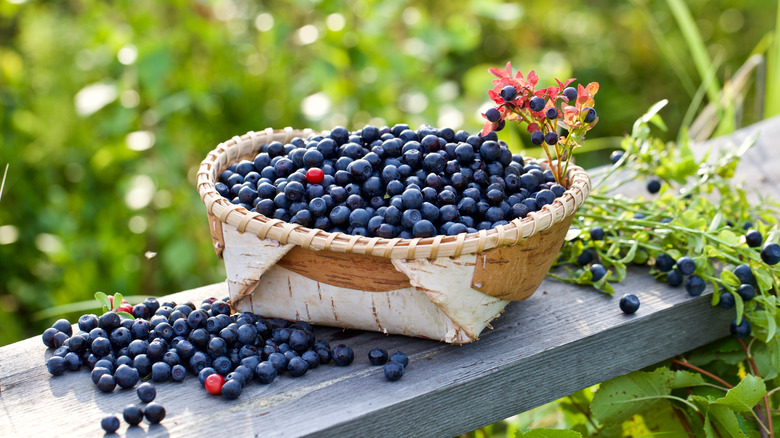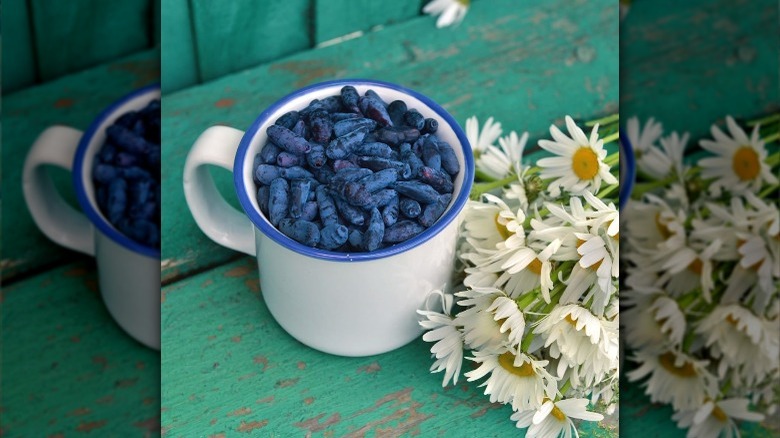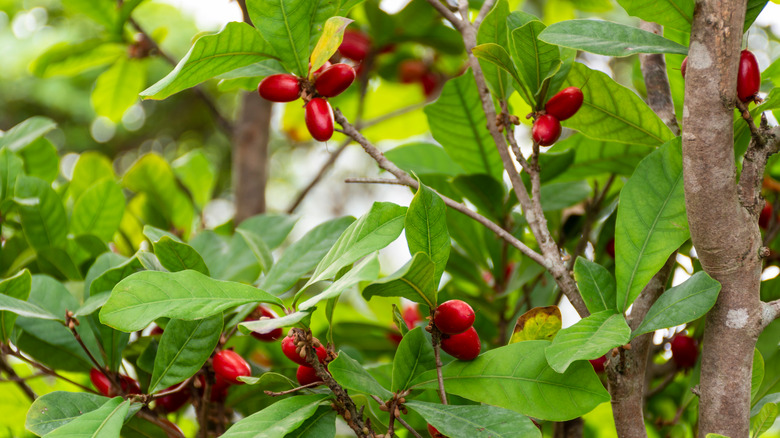30 Types Of Berries And What Makes Them Unique
A berry welcome presence: berries seem to ring in the arrival of spring and summer. Berries are small and bright bursts of flavor that liven up desserts, smoothie bowls, and even salads. Berries are not only beautiful and tasty, but they also have many reported health benefits. They can contribute to overall body health and generally contain a powerful mix of nutrients and vitamins (via WebMD). Some studies mentioned in The Atlantic go so far as to suggest that berries may even play a role in preventing cognitive decline through their high concentration of antioxidants. Beyond that, there are many berries that carry their own unique benefits.
There's a world of berries out there! Literally. There are many berries that remain obscure to the grocery store market and are begging to be let into the kitchen. Whether you're on a health kick or simply trying to add some new flavor to your day-to-day, here are thirty berries, from the tried-and-true to the exotic, and some of the ways they can be enjoyed.
Currant
Currants are currently not the most well-known berry stateside. This petite and bright berry is worth getting to know, though! It's incredibly popular overseas in Europe and can be found in everything from smoothie bowls to sodas. In fact, the "purple" flavor in sodas and candies in Europe and Australia tends not to be grape but rather blackcurrant.
Conversely, currants are all but unknown in the American market. Business Insider notes that less than 0.1% of Americans could describe their taste, which is a distinct sweet yet tangy flavor. Blackcurrants weren't always so obscure in America. They were heavily banned at the beginning of the 20th century due to them threatening the pine industry and have since all but faded from the collective palate.
More and more states have repealed currant bans, and with them creeping back onto farms and plates, it's time to get reacquainted. It makes sense to start on the health side of things: currants have a high amount of vitamin C, so high, in fact, that Business Insider pointed out that currants were once given to English children to prevent scurvy. Additionally, these little powerhouses have about double the amount of antioxidants as blueberries (via Northwest Wild Foods).
Garden variety currants are both red and black, though golden varieties are increasingly common. Currants can be used in any number of ways, from jams to baked goods or a simple yet bold garnish to any smoothie bowl.
Loganberry
The loganberry is the lovechild of the beloved blackberry and raspberry. Gardeners' World notes the brief history of this young Californian berry, which was bred in the late 19th century by amateur botanist James Harvey Logan, thus, loganberries.
It's not hard to see each berry's influence on the loganberry; it's shaped like a blackberry but as bright and deep red as a raspberry. Notably, its color does begin to deepen to the point of almost purpling as it ripens. Loganberries do not soften like other berries as they mature and instead, have a sharp, citrus-like taste due to their high vitamin C content (via BBC Good Food). Loganberries are much tarter than their parent berries, and, if not palatable raw, can be made into a refreshing jam, sorbet, or ice cream.
Loganberries are a bit rare and slightly harder to find in stores. This is partially due to the fact that the sensitive berries must be hand-harvested and also have a short shelf life, as noted by Gardeners' World. For those living in a mild and moist climate like that of the Pacific Northwest, cultivating loganberry might be the right investment for a beautiful and bountiful plant. The rest of us might have to find our way out west to indulge in this unique berry.
Blueberry
The true blue themselves; blueberries are a well-known and well-loved treat. WebMD notes that these blue beauties have been on the American national market since the 20th century. Blueberries are actually native to North America, even referred to as the North American blueberries by some, and have enjoyed consistent popularity since the mid-20th century.
For those unfamiliar, blueberries are a rotund and petite fruit with a tart yet slightly sweet flavor. Blueberries are rich in antioxidants and vitamin K and have even been recognized by the American Heart Association as heart-healthy. It's safe to say that blueberries can be a tasty way to make anyone's diet healthier.
This isn't to say that blueberries are always healthy; the tiny fruit's bold coloring and flavor have made it a welcome addition to many desserts and sweet treats across the nation. If looking to try an old favorite in a new way, why not try blueberry dumplings? This filling recipe calls for freshly made mild southern-style dumplings that are then steamed with stewed blueberries. To add a comforting twist, top it off with a bit of heavy cream. It may not be healthy, but it sure does feed the soul.
Wild blueberries
There isn't a better name for the North American blueberry's wilder cousin than wild blueberry. The blueberries that are primarily in grocery stores are so-called highbush blueberries. North American wild blueberries, on the other hand, grow from Maine to Canada and into Alaska, where they thrive in the region's glacial soils. The reason they're referred to as high-or-lowbush blueberries is simply due to the height of the blueberry bush that the berries grow on. Wild blueberries are markedly different from their more well-known counterparts; they are smaller, darker, and tangier (via The New York Times).
Wild blueberries are astoundingly nutritional and rich in the same antioxidants while being low on sugar compared to highbush blueberries (via Food Nerd Inc). Wild blueberries do not travel well and are primarily sold outside their native region frozen or processed as, say, wild blueberry syrup. There are many reasons to travel to Alaska, but going to enjoy the region's fresh blueberries as a nice summer treat is definitely one of them. Salmon with wild blueberries might just be a winning combination best eaten fresh, but wild blueberry scones and pancakes are a more traditional way to enjoy these berries.
Rose hip
Some might not know that rose hips are technically a berry, but, indeed, rose hip berries are only one of the many amazing parts of the rose plant. Rose hips are the fruits that grow into relatively large bell-shaped berries after the rose plant finishes blossoming (via Brooklyn Botanical Garden). Rose hips, just like roses, grow on a vast spectrum. LiveStrong notes that rose hips are typically larger red-to-orange fruits and are high in vitamin C. Rose hips have a sweet flavor with a slightly tart aftertaste. Also, it's important to know that rose hips do not grow on modern rose varieties.
Rose hips may not be common in American cuisine but have long had a formidable place in Middle Eastern and Southeast Asian, specifically Chinese cuisine. In traditional Chinese medicine, rose hip tea was long served not only as a comforting and warm drink but to boost the immune system (via WebMD). Rose hips can also be served to indulge; the incomparable Saveur offers a forager rose hip syrup. This modified simple syrup uses freshly collected or dried rose hips to create a beautiful red simple syrup. The magazine's suggestions? Pour it over a nice bowl of ice cream, or use it for a particularly classy cocktail.
Mulberry
Contrary to Shakespeare, these mulberries will be handled. Despite their prevalence in literature and nursery rhyme, mulberries are a rarer treat. This can be partially attributed to the fact that mulberries, like so many of the other berries on the list, do not travel well. So, what's the deal with these berries? Mulberries are juicy multi-clustered conal berries with an idiosyncratic taste: they are simultaneously sweet and tangy with a note of white cedar. These syrupy berries are known to easily stain (via Specialty Produce). Mulberries, like other berries on the list, are rich in vitamin C. WebMD describes the berry as having a high concentration of phenolic acid which acts as an antioxidant. Mulberries can be found in white, black, and red. Red mulberries, however, are the only variety native to and commonly found in the United States (via the Polyculture Project).
Mulberries are a welcome summer treat and a companion to many: sweet mulberry pairs nicely with many kinds of cheeses, can be fashioned into an aromatic wine, or made into a flavorful cobbler. Compared to the berry, the mulberry tree is an extremely laid-back plant that does not need much, if anything, to thrive. Perhaps those who have a keen desire for fresh mulberry should turn an eye and thumb towards mulberry cultivation.
Gooseberry
Gooseberries, despite the name, have no relation, appearance, or connection to geese. In fact, the etymology (rather convolutedly) traces back to mean crisp berry, which is a very apt description of this crisp and crunchy berry (via British Food History). Gooseberries, also known as amla, have not been popular in American kitchens. Similar to currants, gooseberries were banned in the States for the same threat posed to the pine industry.
The original federal ban on gooseberries was repealed in the '60s, and since then, gooseberries have been let back in on a state-by-state basis. If given a chance, one should indulge in gooseberries. They are a plump fruit that delightfully pops in the mouth and has a striking appearance in purple, pink, or green. Their bright stripes almost make green gooseberries look like mini-watermelons. Gooseberries are known for having a tangy, grape-like flavor.
Compared to other berries, gooseberries have an exceptionally long shelf life and can be found in grocery stores and farmers' markets. A lot of farms even offer a fun pick-your-own option for gooseberries. Gooseberries pair exceptionally well with savory dishes like a gooseberry ketchup topped mackerel. In the sweeter realm, try whipping gooseberries into a nice compote or tangy mint-infused lemonade.
Huckleberry
Huckleberry — not Huckleberry Finn. Where exactly did this name come from, and did Mark Twain name his famed character after the fruit? Though the history behind the huckleberry name is still enigmatic, the history is not. The huckleberry is a berry native to the Pacific Northwest. This petite and dark blue berry is more often than not mistaken for the beloved blueberries and was even misidentified as a European blueberry at first (via Allrecipes).
It takes one glance at the berries to understand the old mix-up; huckleberries look virtually identical to their blue counterparts. It often takes a trained eye to distinguish between the two. An important distinction is that some rarer huckleberries can also be bright red and have tough and bitter seeds. These berries are filled with all sorts of goodies and are extremely rich in antioxidants and vitamin C (via Northwest Wild Foods). Huckleberries are tarter than the blueberry, and NPR describes their taste as "legendary."
Similar to wild blueberries, huckleberries grow best without proper cultivation and, more often than not, need to be foraged. But where can huckleberries be found? According to Garden Guides, huckleberries are scattered across the United States in a variety of climates, though a considerable amount are out west.
Saskatoon berry
Another interestingly-named regional berry that resembles blueberries is the saskatoon berry. Despite the resemblance, saskatoon berries are most closely related to apples (via the Saskatoon Berry Institute of North America). Sometimes referred to as juneberries, the name "Saskatoon" relates to the region that the berry is most intimately linked with, Saskatchewan. Saskatoon berries are plump little things that only deepen in their rich purple color as they mature. Like huckleberries, saskatoon berries have a sweet taste, albeit paired with a down-to-earth nutty flavor. The dark skin of the saskatoon berry is extremely sensitive and, like other dark berries, tends to break easily and stain both skin and cloth, as seen in the above picture.
Similar to most berries, saskatoon berries have a potent medley of vitamins and antioxidants. One study has found that saskatoon berries may have powerful anti-diabetic effects and have an insulin-like effect on the body, though the scientific jury is still out. Saskatoon berries primarily grow in the northern and western parts of the country and aren't readily available in grocery stores (yet), but can be ordered online. The complex flavor of saskatoon berries lends itself well to baking, and a fantastic use of the berry is as a traditional saskatoon berry pie.
Boysenberry
Boysenberry might be a more familiar face on the breakfast table in the form of boysenberry syrup. Boysenberries are fabled to be a cross between raspberries, blackberries, and loganberries (via Boysenberries New Zealand). The berry was the work of Swedish-American botanist Charles Rudolph Boysen, who literally put the "boysen" in boysenberry.
Well, actually, as Food and Wine points out, Charles Rudolph floated his hybrid berry to Walter Knott of Knott's Berry Farm fame, and it was Knott who commercialized the berry and named it after the botanist. It's definitely the boysenberry's varied ancestors that contribute to the berry's complex flavor: juicy like a blackberry, all the while maintaining the sweet floral notes of the raspberry and tanginess in its own unique way. Beyond taste, boysenberries are particularly fibrous and contain a slew of healthy phytochemicals, which contribute to an especially well-balanced diet.
Boysenberries were first introduced to the American market by the mid-'30s, though they've fallen short of commercial success in the U.S. due to their short shelf life (via Britannica). Boysenberries can still be found growing in the milder west in the U.S., especially at farmers' markets and through private cultivation. Though their shelf life is short, boysenberries preserve well. If one has the time, travel out to the Knott's Berry Farm Boysenberry Festival for a slice of history and a darn good boysenberry pie or an inventive boysenberry soft serve.
Barbados cherry
The barbados cherry carries many hats: it's also known as the West Indian cherry, wild crepe myrtle, bajan cherries, or acerola. Barbados cherries are not really technically the stone fruit cherries that most of us know, but they are roughly the same size and have a somewhat similar red hue, which is where their name most likely comes from. Barbados cherries have yellowish-orange flesh, have three pits, and are sweet while somewhat tart in flavor (via In the Kitchen with Matt). As described by the site, barbados cherries aren't really the same as the stone-fruit cherries. One can speculate that the name comes from the barbados cherry's resemblance to the common fruit, though it is more plump.
The food blog goes on to note that barbados cherries are very nutritious, high in vitamin C, have good amounts of minerals and antioxidants, and help to boost immunity. Notably, musician and pop culture icon, Rihanna, infuses the bajan cherry in her skincare line. Beyond topical application, it seems like this tropical fruit is starting to pick up hype as a potentially untapped superfruit. Trader Joe's has started carrying purée packets and juice shots, so perhaps a meteoric rise is on the horizon for this once simple treat (via Forbes).
Salmonberry
Salmonberries are quite the catch, or rather, quite the find. Another member of the rose family, salmonberries are mainly found on the west coast from Oregon to California and, interestingly enough, as far out east as Japan. Salmonberries are wild berries that are not commercially cultivated and must be carefully foraged in order to be enjoyed.
Properly identifying these berries shouldn't be all that challenging; salmonberries most likely get their name from their startlingly orange-red hue, which resembles the skin of a slice of salmon. There is speculation that the bold name might also derive from a translation from a local indigenous language, as these berries were often eaten with salmon (via the Spruce Eats). An article through Hakai Magazine illustrates the continued meaningfulness of salmonberry in coastal indigenous culture through food, culture, and medicine. Indeed, it has been noted by the U.S. Forest Service that salmonberry tea can be used to treat everything from diarrhea to dysentery.
Salmonberries are bold in look and mild in taste; their flavor is described as tangy and rhubarb-like in nature. Some don't enjoy the bright orange berry due to the number of seeds it carries and thus, prefer to enjoy it in jams or jelly. In this sense, one need not hunt and gather these bright beauties — there are plenty of jams and jellies to enjoy for those who live too far away.
Chokeberry
Well, what's in a name, anyway? A little bit, at least. Chokeberries, also known as aronia berries, are most likely called what they are due to the fact they are too astringent for most to eat raw (via University of Minnesota). Despite their less-than-appealing taste, there are a lot of medical benefits to these bitter berries. Multiple studies have found that aronia berries have anti-cancerous and anti-diabetic effects, all the while being "nutrient-dense" (via Medical News Today). Some Indigenous communities used aronia tea and juices to treat colds (via WebMD). Of course, because aronia berries are so deep in color, they carry anthocyanins, an antioxidant that is found in most dark berries.
Chokeberries are small berries that grow in clusters on bright red stems. They are plump and soft to the touch with a slightly musky scent. There is also a red chokeberry variety, often referred to as the brilliant red chokeberry. These berries also have many vitamins, though perhaps not as many anthocyanins. According to North Carolina State University, red chokeberries are slightly sweeter and more palatable than the darker variety. They are regularly used to make bright red jams and jellies. Chokeberries are so rich in antioxidants yet so bitter that they truly lend themselves well to juices, powders, and supplements that can be purchased online easily. With that in mind, though, not much beats fresh fruit health-wise. Though chokeberries are not carried in many major grocery stores, they can often be found in health food stores.
Lingonberry
Lingonberries are especially popular in Scandinavia, where they can be found popping up in many different dishes but maybe most famously in IKEA'S meatballs with lingonberry jam. It makes sense that the berry and region are so intertwined, as lingonberries originally come from the cooler areas of Northern Europe. Lingonberries are round and bright red berries that are small in stature and big in taste. Lingonberries are most similar to the better-known cranberry in overall flavor, but lingonberries are slightly tarter, much sweeter, and compactor. It does make sense that lingonberries share so much in common with cranberries, as they are closely related to both cranberries and blueberries, according to Britannica.
Lingonberries are full of vitamin C, and it is possible that lingonberries have an anti-inflammatory effect and can be used to treat ailments such as UTIs (via WebMD). Anyone can try their hand at recreating some Scandinavian meals by adding an authentic twist with lingonberries. The familiar and beloved IKEA'S meatball and lingonberry duo might be the place to start, or maybe as a sweet linzer tart pressed with lingonberry jam.
Marionberry
Another member of the blackberry, raspberry, and dewberry family, is the marionberry. Also known as the waldo berry, this delightful berry is another West Coast treat. These berries are actually an Oregon-exclusive delicacy. At first glance, blackberries and waldo berries look identical. In fact, the waldo berry technically is a blackberry, as it's the hybrid between two different blackberry varieties, the chehalem and oallieberry.
Food and Wine provides a succinct differentiation between marionberries and blackberries: marionberries are one of the more recent iterations of the blackberry, as they were first cultivated in 1948 by Dr. Waldo and then taste-tested in Marion County. It's pretty clear where the two names of the berry come from. Marionberries have an earthier yet complexly rich flavor and were bred to have a firmer texture to allow for better shipping. It seems like all the pins are set up for the waldo berries to surmount the throne and, as Food and Wine described, take their place as the "king of the blackberries."
For the time being, however, they remain Oregon's not-so-hidden secret. A little more than half of all blackberries grown in the damp state are marionberries, and as NPR describes, there is a certain "obsession" surrounding the fruit in Oregon state. If looking for a little taste, it's best to turn towards one of the many regional products like marionberry beer.
Barberry
The barberry is a prominent medicinal plant, where just about every part of it contributes to health and well-being. It seems like the list of possible effects of the berry is never-ending: from anti-inflammatory to anti-microbial to hypotensive and sedative (via Mount Sinai). Barberries themselves are ovular berries that turn a brilliant bright red and orange color as they ripen. Barberries are tart, and their small size allows them to add a certain pop to savory dishes, as noted in Cooks Illustrated.
Barberries are native to the Middle East and Southeast Asia, where they are popular in many dishes, like zereshk polow, a basmati rice that is served with saffron and topped with barberries. Their tart flavor also makes them a good baseline in preserves, and their orange coloring makes for a boldly colored jam (via Chef's Mandala). Do note, barberries are actually an invasive plant in North America, which makes them few and far to come by. It's a lot easier to find dried barberries, for example, that make a wonderful addition to salads, granola, and other foods alike. If adding the berries to rise dishes, make sure to soak them for a softer texture.
Elderberry
Once referred to by the father of modern medicine, Hippocrates himself, as his own personal "medicine chest," the elderberry is an amazing medicinal plant (via JSTOR Daily). Elderberries are speculated to be rich in antioxidants and vitamins, and provide a major boost to the immune system. It's used in a variety of medicines for an array of ailments. Do keep in mind, however, as one medically-reviewed article notes, elderberries may provide these effects and act more so as a flu relief than as a flu treatment (via Very Well Fit).
The elderberries are cluster berries with a dark purple color both in flesh and juice. If handling raw elderberries, be careful as they stain skin and clothes very easily. Though there are bigger things to be mindful of when dealing with raw elderberries: they are not safe to consume! Raw elderberries are toxic when ingested raw.
It is absolutely imperative to keep in mind that elderberries are only safe to eat once they have been cooked (via Norm's Farms). If looking to take elderberries for health purposes, perhaps a health supplement is the right thing to remember, though keep in mind they are, for the most part, unregulated. Commercially produced elderberry juices also add an excellent vitamin C boost while remaining absolutely safe to consume.
Yellow Raspberry
Golden raspberries are a stunning and rare variation of the beloved red raspberry. Golden raspberries seem to glow right from the branch. What gives these berries their unique coloring is a genetic mutation carried recessively through different raspberry plants (via Gardening Know How). Golden raspberries aren't just visually distinct; they also are sweeter and milder in flavor than their brazen brothers. Some even note that golden raspberries have a tangy, almost apricot-like flavor. Their mellow flavor pairs well with bolder flavors, like vanilla and chocolate or this golden raspberry and basil sorbet.
Gold raspberries are just like raspberries in the sense that there's a lot of good that comes with eating them. This fibrous fruit is brimming with antioxidants and enough vitamin C to give the immune system a nice kick. These sun-colored berries also brighten up otherwise bland smoothie bowls and can make a bright spot on otherwise dark salads, and some studies show that bright foods can even help improve emotional moods.
Gold raspberries are a bit rarer and hard to come by in the day-to-day grocery store, and they are more often than not cultivated by farmers specifically. Though they are not often found in grocery stores, yellow raspberries are a farmer's market darling.
Kiwi berry
Kiwi berries: are they the same as kiwifruit? Well, the simple answer is... Kind of. Kiwi berries, also known as the hardy kiwi, belong to the same family as the fuzzy kiwifruit. Unlike its better-known relative, kiwi berries are much, much smaller. Kiwi berries truly look like as if a kiwi had been shrunk with a ray gun. They have smooth skin and as some have noted, have a much more complex taste that is sweeter and more acidic than the larger kiwi fruit (via Delish). As PCC Community Markets points out, the compact kiwi berries are dense in nutrients and carry, for example, five times the amount of vitamin C than oranges!
Kiwi berries do well in cool and damp climates and have long been more popular in the countries where they grow best: China and Korea (via Better Homes & Gardens). Kiwi berries have begun making waves in the U.S., though they still may be few and far between as they can only grow in the milder parts of the country. But, if when stumbling upon these sweet and tangy berries, be sure to scoop them up! Kiwi berries soften as they ripe, so find a good pair and enjoy them after a good rinse! It doesn't get much easier than that.
Buffaloberry
Maybe buffaloberries get their name from the Great Plains where they originate. These gorgeous windswept plains are tough to live on, but the shepherdia plant is a plant that will survive in the most adverse of conditions. By summer's end, bright red or golden yellow berries will begin to ripen on the plant's branch and are, as the saying goes, ripe for the taking (via Britannica). Buffaloberries are currant-like berries that are tart in flavor, and though they may be one of the more obscure berries on this list, this might just be the calm before the hype. Business Insider heralded the buffaloberry, also known as the rabbit berry, as a potential superfood. Buffaloberries are rich in lycopene, an antioxidant that has been shown to have an anti-cancerous effect.
The taste of fresh buffaloberries is, however, not for everyone. One journalist for South Dakota Magazine went so far as to like the taste of buffaloberries to Death Valley, although the same writer did advise buffaloberry neophytes to persevere for an "elite" treat. Buffaloberries sweeten considerably once dried, and their acidity has made them particularly good for winemaking. Though do keep in mind, the sweetness is a pay-off for nutrients!
Goji berry
Goji berries were heralded as something of an elixir and were hyped as a simple solution to the complex problems of health and wellness. In reality, it's a bit more nuanced than that. While there isn't one clear-cut way to be healthy, incorporating healthy choices into the everyday diet is certainly a worthwhile pursuit. In this sense, goji berries do not disappoint.
These bright red berries first grew in China, where they have enjoyed importance in both diet and medicine for ages (via the BBC). Time has not faded goji berries, also known as wolfberries, and in the last couple of decades, they have, if anything, risen to greater global prominence. This really is for a multitude of reasons, but mainly because these beautiful berries are known to be very nutritious. Goji berries are brimming with vitamins and antioxidants and even are a (slight) source of protein (via WebMD). Goji juice, in particular, has been shown to aid overall health and even improve sleep wellness.
Goji juice tends to be pricey, and those with access to the means might want to try their hand at making fresh goji berry juice. When turning an eye back toward Chinese cuisine, goji berries can be made into a filling and nutritious chicken soup. That certainly would be a happy companion while healing from the flu and might even give the kick needed for a speedier recovery.
Juniper berry
As the Smithsonian Magazine so boldly asks: what should we do with juniper berries? Juniper berries are distilled to make gin and give the classic spirit a welcome and sharp twist (via Spirits Hunters). While gin and tonics are a longtime friend of cocktail hours, there is intrigue and merit to the juniper berry on its own. Though juniper berries are not botanically a berry, they are, per the culinary definition, a berry. To follow the Smithsonian's questioning, well, what the heck does that mean? It means that while technically juniper berries are not classified as a berry, they function and taste like one.
Juniper berries, as noted, have a sharp, somewhat pine-like taste to them. They are, in short, unignorable and should be used with absolute caution as they do have the tendency to overpower. Juniper berries are native to the Northern Hemisphere and can be found in traditional English, German and Alsatian cuisine. Its sharp taste pairs especially well with savory meat dishes to add a nice twist, like in bacheofe, a savory meat and vegetable stew peppered with juniper berries. Juniper plays well with other berries and can often be found in a medley of desserts, like this blueberry-juniper rye cake. However, an important catch, as pointed out by the Smithsonian, is that pregnant women should avoid juniper berries as they are known to cause uterine contractions.
Cloudberry
Perhaps the most delightful name on the list, the cloudberry's characteristic fruit clusters look like a puffy delight. Cloudberries can also be found under the alias yellowberry, malka, or baked apple berry (via Britannica). Cloudberries might appear similar to the salmonberry, and indeed they are often confused with each other or combined into one berry. This might be due to the fact that another name for cloudberry is the lowbush salmonberry.
That said, some differences separate these two wondrous berries. One can look at the main difference between salmonberries and cloudberries as between that of blueberries and wild blueberries. Cloudberries are lowbush, meaning they grow closer to the ground, whereas salmonberries grow on shrubs. Furthermore, salmonberries are almost exclusively found towards the west of the country, while cloudberries are much more distributed throughout the coasts and even across the Atlantic. The cloudberry remains a highly sought-after delicacy in many Nordic countries, even being described as "the North's most sought-after fruit" (via Scandinavia Standard).
Since cloudberries are in the same family as the salmonberry (and blackberry), and have a distinguishable tartness, characteristic to the bramble fruit. Something important to note is that these berries tend to even out with age, even taking on a creamier, even somewhat savory, texture as they mature. In Finland, cloudberries are paired with cheese to make the one-of-a-kind leipäjuusto dessert.
Açaí berry
Açaí berries are synonymous with açaí bowls that have taken vegan restaurants, juice bars, and breakfast tables by storm. Beyond its relatively stable popularity in the U.S., açaí berries have long been a major staple in the diets of its Brazilian homeland (via The Nature Conservancy). Not only is açaí filling, it has long been believed by Amazonians and Brazilians to be majorly beneficial to health. The Mayo Clinic chimes in and confirms that while the açaí berry contains many healthful benefits that berries are known for, there is no one conclusive study showing that it is a miracle cure for ailments.
Those looking to try açaí berries and not açaí purée or juice will be a bit disappointed to hear that the fruit is primarily sold pre-processed as it spoils very quickly (via The Spruce Eats). No matter, açaí is even mainly eaten as pulp in Brazil, as well! Not only does açaí berry pulp have a longer shelf life, but the fruit's unique earthy flavor lends itself as a good building block for a fruit bowl topped off with fresh berries and a sprinkling of granola for crunch. If looking for a sweet treat, try out another Brazilian food trend, and treat yo' self to an açaí ice cream.
Blackberry
Now on to the most illustrious of the bramble family: the blackberry. While blackberries are well known to most, there may still be a few surprising facts to this well-known fruit. Blackberries are small ovular fruits that are marked by their dark color and tartness that molts into a rich sweetness as the berry ripens. It's this versatility that lets blackberries find their place in cocktails, like the well-known bramble cocktail, and sweet summer cobblers alike.
This sweet berry also has major health benefits. Blackberries are chock-full of the same antioxidants that characterize other dark fruit, such as blueberries. According to WebMD, blackberries have the potential to aid digestion, manage diabetes and even combat obesity (via WebMD). Not too shabby for a common fruit, eh? While blackberries might be a common find in grocery stores, it might be advantageous to look into a pick-your-own opportunity and bring home some fresh and ripe goodies to your own kitchen.
Sea buckthorn
The sea buckthorn is a beautiful plant; its fuzzy silver leaves are offset by clusters of bright orange berries. It's common (although unusual) name refers most likely to the plant's affinity for growing along European coastlines. The plant's Latin name roughly translates to "shiny horse," as horses fed sea buckthorn grew lustrous coats.
National Geographic published an article on sea buckthorn, referring to the fruit as "miracle berries." Of course, whether a berry can be a miracle is disputed; the exposée nonetheless describes the berry's reputation in the Middle East as a wonder fruit capable of bringing health and encouraging weight loss. Though the sea buckthorn's effect remains well within the realm of healthy doubt, as the article points out, the sea buckthorn berry is filled with vitamin C, fatty acids, and an assortment of other beneficial nutrients. To top it all off, sea buckthorn has a refreshing, tart, and slightly acidic taste that is heartily palatable for most. It is what the author of the aforementioned article describes as something "between a tart lemon and a sweet apricot" and an absolute delight.
According to Gardening Know How, sea buckthorn berries are still hard to come by in the United States, though they are more easily found as a jam which might just add a perfect touch to Sunday morning toast.
Mountain ash berry
Mountain ash berries, also known as rowan berries or dogberries, are a berry that can be found in the United States, albeit only in the northern parts of the country. Mountainberries, like many other berries, are rich in vitamin C and are used to treat PMS and menstrual cramps holistically. One should bear in mind, as per WebMD, however, that eating too many mountainberries can, however, inversely cause stomach irritation. In fact, mountainberry seeds contain a small amount of cyanide which is poisonous if consumed in very large quantities (via Newfoundland & Labrador Flora).
Mountainberries are bold orange and globular berries that are ready to be picked come September. Despite their relatively early ripening, these berries will persist and hang onto mountain ash trees well into the winter. In fact, they provide important nourishment for winter birds (via Montana Public Radio). While mountain berries themselves are often too sour and acidic to eat raw, they tend to mellow out when simmered. Their high levels of pectin, a naturally occurring plant starch, allow for a particularly thick jam. This is most likely why one of the mountainberry havens, Newfoundland, is known for its dogberry jam.
Bilberry
Bilberry buds bloom blueberry-like bilberries. Try saying that three times fast! Bilberries, from the Danish bollebar or "dark berry," are certainly similar to blueberry and other blueberry counterparts, however, there are certain things to bear in mind. Bilberries have, historically, been much more popular overseas, even referred so far as alternatively as European blueberries. The National Center for Complementary and Integrative Health cites that the bilberries have enjoyed a reputation as a medicinal plant since the Middle Ages. Similar to currants, bilberries have been used to treat scurvy, due to their high vitamin C content.
Bilberries are smoother, denser, and darker in color than North American blueberries. Bilberries partially thank their deep color to the medley of antioxidants, which are speculated to have many healthful effects on the body (via Verywell Health). For those who are looking for a more culinary pursuit with bilberries, The Spruce Eats does make the observation that bilberries really shine when they're baked into confections or paired with game meats. The Swedish dish Hjortiflé med blåbärssås is a heart and stomach-warming combination of venison with a stewed bilberry sauce.
Honeyberry
If honey is what catches the flies, then what about honeyberries? Despite what one might assume from the name, honeyberries are oblong blueberries with a light purple dusting to them. Honeyberries might get their name from the fact that they belong to the same family as the honeysuckle. The Japanese name for honeyberry, "haskap," descriptively means edible blue honeysuckle, and well, there simply is no better way to describe this berry (via Jungseed).
Honeyberries have a delightfully enigmatic taste — it's almost impossible to pin one particular direction down. Honeyberry connoisseurs tend to place the berry's flavor profile somewhere between kiwi, grapes, cherries, and blackberries. Though honeyberries call Eastern Europe and Southeast Asia home, they can now be found popping up in the cooler parts of the United States, as reported by Better Homes and Gardens. Honeyberries are healthy, too, carrying more anthocyanins (anti-inflammatory antioxidants) than blueberries and blackberries. They're also a good source of fiber and vitamin C. While honeyberries can be made into jams and jellies, their unique flavor is perhaps best enjoyed raw. Keep an eye out during early to midsummer at farmer's markets to indulge in this on-the-rise berry.
Miracle berry
Miracle berries have certainly more than earned their namesake. This ovular deep red fruit is a curious wonder. The berry contains the protein Miraculin, which changes the receptivity of taste buds, usually to perceive sour foods as sweet (via the Pacific Science Center). Miracle berries throw a sort of UNO reverse card on taste receptors, and the more acidic the food, the sweeter the taste. Vice versa, of course, is also the case. The effect of the miracle berry is said, according to the Cupcake Project, to last anywhere from thirty minutes to a full hour. The blog notes that it's imperative to not eat the berry quickly — it's the fruit being on the tongue (the center for taste) that gives it its effect. It's advisable to leave the berry on the tongue for a few seconds and then bite into it and allow for the juices to linger on the tongue.
Miracle berries themselves are tangy in flavor and delicious. While there is speculation that this fruit may just take the sweetener market by storm, for the time being, it remains relatively hard to come by. While some prefer purchasing the rarer miracle berries at a (pretty high) cost, there are miracle berry tablets that have the same effect at a lower price point.
